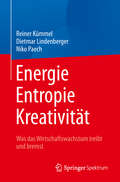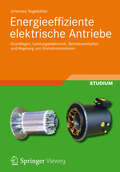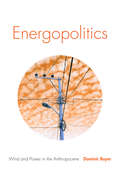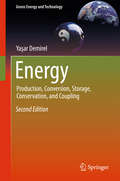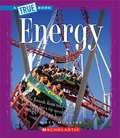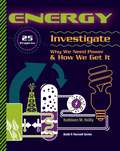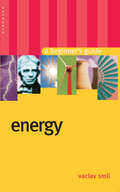- Table View
- List View
Energie der Alpen: Grundlagen und Zusammenhänge nachhaltiger Energieversorgung in der Alpenregion (essentials)
by Oliver D. Doleski Klaus LorenzAls einzigartiger Natur- und Kulturraum ist die Alpenregion von landschaftsverändernden Eingriffen der Energiewirtschaft besonders betroffen und daher lautet die Kernfrage des Autorenteams um Oliver D. Doleski und Klaus Lorenz, kann bzw. wie soll der Alpenraum perspektivisch zu einer europäischen Energiekonzeption beitragen, ohne den Lebensraum Alpen zu gefährden. Die Autoren schneiden dabei komprimiert neben energiewirtschaftlichen Grundlagen Fragen der nachhaltigen Versorgung moderner Gesellschaften mit Strom und Wärme, des Erhalts weitgehend unerschlossener Räume, die Rolle wesentlicher Akteure, die Partizipation der Bürgerschaft und Facetten der Netzwerkbildung ebenso wie gesellschaftspolitische, soziologische oder historische Einflussfaktoren an.
Energie, Entropie, Kreativität: Was das Wirtschaftswachstum treibt und bremst
by Reiner Kümmel Dietmar Lindenberger Niko PaechDieses Buch hilft dabei, die Bedeutung der Thermodynamik für Wirtschaft, Umwelt und Gesellschaft zu verstehen. Es plädiert für die Integration der ersten beiden Hauptsätze der Thermodynamik in die Lehrbuchökonomie. Dabei führen systemische Gemeinsamkeiten in der Thermodynamik und in der Theorie des Wirtschaftswachstums zur Verwendung ähnlicher mathematischer Methoden, die es erlauben, industrielle Volkswirtschaften realitätsnah zu beschreiben. Davon ausgehend schlagen die Autoren Instrumente zur Lösung der Sozial- und Umweltprobleme vor.Das Buch richtet sich an alle, die sich für interdisziplinäre Forschung zu den Entwicklungsproblemen von Wirtschaft und Gesellschaft interessieren und verstehen wollen, was deren Umbrüche treibt. Mit diesen Entwicklungsproblemen beschäftigen sich seit langem die Autoren des Buches: der theoretische Physiker Reiner Kümmel von der Universität Würzburg, der Physiker und Ökonom Dietmar Lindenberger von der Universität Köln und dem Energiewirtschaftlichen Institut an dieser Universität und der Ökonom Niko Paech von der Universität Siegen.“Es ist mir ein Vergnügen, den Lesern dieses Buch zu empfehlen. Es wird von der Idee getrieben, die physikalischen Grenzen menschlichen Wirtschaftens mithilfe der Thermodynamik auszuloten, einer der universellsten physikalischen Theorien, die wir haben.“Dieter Meschede, Professor für Physik, Universität Bonn
Energie ist nicht erneuerbar: Eine Einführung in Thermodynamik, Elektromagnetismus und Strömungsmechanik (essentials)
by Wolfgang OsterhageWolfgang Osterhage stellt die für eine praktische Energiegewinnung erforderlichen Kenntnisse der Strömungsmechanik und des Elektromagnetismus vor. Er baut seine Grundlagenüberlegungen auf den beiden Hauptsätzen der Thermodynamik auf, die besagen: Es kann an Energie nichts hinzugefügt und nichts hinweg genommen werden. Und: Wir verlieren bei jeder Umwandlung nutzbare Energie. Der Autor behandelt zudem Energiebilanzen, die Konzepte von Anergie und Exergie sowie die Rolle der Entropie in physikalischen Prozessen.
Energie und Entropie - was ist das wirklich?: Ein Überblick über die Definitionen in der Thermodynamik (essentials)
by Klaus StierstadtDieses essential beschreibt zwei der wichtigsten physikalischen Begriffe, die Energie und die Entropie. Die innere und die äußere Energie von Materie und Feldern wird definiert und an Beispielen erläutert. Die Energie kann in vielerlei Formen existieren, die zum Teil ineinander umgewandelt werden können. Ob das möglich ist oder nicht, das beschreiben der Zweite Hauptsatz der Thermodynamik und die Entropie. Diese kann auf zweierlei Weise definiert werden, auf thermodynamischer und auf statistischer Grundlage. Der weitgehend geheimnisvolle Begriff der Entropie wird erläutert und seine Missdeutungen werden beschrieben.
Energie- und Produktionswende im ländlichen Raum
by Bernhard Adler Martin Dykstra Michael WintersteinVorliegendes Buch möchte Experten verschiedener Wissensdisziplinen ansprechen, vor allem Agrartechniker, Energetiker und Recyclingspezialisten. Es geht darum, die Vorteile einer zukünftigen Agrar-Energiegesellschaft zur Bewältigung der Energiewende darzulegen. Von diesem Strukturwandel ist im Grunde die gesamte Zivilgesellschaft betroffen, letztlich jeder einzelne Bürger als Konsument. Deshalb versuchen die Autoren in allgemeinverständlicher Form den Energiewandel als eine Einheit von neuen Technologien und sinnvoller Energieeinsparungen darzustellen. Mit dem Agrar-Energie-Komplex propagieren sie ein Wirtschaftsmodell, das Landwirten zukünftig eine gesicherte Existenz bilden kann.
Energieeffiziente elektrische Antriebe
by Johannes TeigelkötterDer effiziente Einsatz elektrischer Energie in der elektrischen Antriebstechnik ist notwendig, da hier ca. 2/3 der erzeugten elektrischen Energie verbraucht werden. In diesem Lehrbuch werden die notwendigen technischen Grundlagen und Methoden zur Effizienzsteigerung in der elektrischen Antriebstechnik behandelt. Insbesondere wird durch eine gründliche Einführung in die Raumzeiger-Rechnung ein detailliertes Verständnis von modernen Antrieben mit Asynchron- und Synchronmotoren ermöglicht. Neben den elektrischen Maschinen werden die Steuerverfahren für Pulswechselrichter, Regelverfahren und Sensoren für energieeffiziente Antriebe beschrieben. Jedes Kapitel schließt mit Übungsaufgaben, um die Lehrinhalte zu vertiefen.
Energieeffiziente Wärmeversorgung von Gebäuden: Tatsächliche Versorgungsverhältnisse und Maßnahmen zur Effizienzsteigerung
by Wolfgang HeßeDieses Buch beschreibt die anlagentechnischen Komponenten für die Wärmeversorgung von Gebäuden sowie die Anlagentechnik und die dazugehörigen Parameter. Es wird beschrieben, wie die Parameter für eine energieeffiziente Auslegung zu wählen sind. Auf diese Weise hilft das Buch dem Praktiker bei einer kundenorientierten und energieoptimierten Umsetzung.
Energieeffizienz in der Industrie
by Markus Blesl Alois KesslerDas vorliegende Buch quantifiziert die Potenziale für mehr Energieeffizienz in der Industrie anhand technologie- und branchenbezogener Analysen. Ausgehend von den methodischen Grundlagen werden im ersten Teil die strom- und wärmebasierten Querschnittstechnologien und -prozesse anhand zahlreicher Anwendungsbeispiele erörtert. Neben so klassischen Themen wie bspw. Beleuchtung oder Wärmerückgewinnung werden auch bisher weniger beachtete Prozesse wie die Trocknung oder die Lackierung erfasst. Der zweite Teil ist der energieintensiven Metallerzeugung und -verarbeitung, der Herstellung der nichtmetallischen Werkstoffe Zement und Glas sowie der Chemie-, Papier- und Lebensmittelindustrie gewidmet. Beide Teile werden abschließend in einen größeren energie- und volkswirtschaftlichen Kontext gestellt. Die Erkenntnisse werden an vielen Stellen zu Checklisten verdichtet und in der Gesamtschau am Ende zu allgemeingültigen Empfehlungen zusammengefasst.
Energieeffizienz in Industrie, Dienstleistung und Gewerbe: Energietechnische Optimierungskonzepte für Unternehmen
by Martin DehliEin wesentlicher Anteil der in Deutschland benötigten Endenergien entfällt auf die Sektoren Industrie, Gewerbe, Handel und Dienstleistungen. Wegen der Vielfalt der dort eingesetzten Maschinen- und Anlagentechniken sowie Fertigungsverfahren stellen sich besondere Anforderungen an Fachleute, die mit den Aufgaben des Energieeinsatzes in Betrieben betraut sind. Das vorliegende Buch benennt zahlreiche Möglichkeiten der Energieeinsparung unter technischen Gesichtspunkten.
Energiemarkt Deutschland: Daten und Fakten zu konventionellen und erneuerbaren Energien
by Hans-Wilhelm SchifferEnergiewirtschaftliche Entscheidungen und technische Weichenstellungen erfordern eine fundierte Datenbasis. Die wichtigsten Zahlen und Fakten zu deutschen und europäischen Energiemärkten (Mineralöl, Braunkohle, Steinkohle, Erdgas und Elektrizität), zu den Eigentumsverhältnisse von über 100 Energieunternehmen und Nachfrage- sowie Angebotsstrukturen sind in diesem Buch vermittelt. Es bietet sich als Nachschlagewerk und Einführung in die vielfältige Thematik an. Über 100 Tabellen und mehr als 200 Diagramme erleichtern den Zugang zu den umfangreichen Daten. Ein Glossar hilft dabei, Klarheit in die unterschiedlichen Begrifflichkeiten zu bekommen. Berater, Entscheider und an Kennzahlen interessierte Leser finden in diesem Buch umfangreiches Material für die eigene fachliche Fragestellung. Der Autor ist Executive Chair of the World Energy Resources Programme des World Energy Council, London. Er war viele Jahre in zwei Bundesministerien sowie in leitender Funktion bei einem großen Energieunternehmen tätig und ist Lehrbeauftragter in verschiedenen Masterstudiengängen an der RWTH Aachen.Aus dem Inhalt- Grundlagen der Energiewirtschaft- Struktur einzelner Energie-Teilmärkte- Erneuerbare Energien- Preisbildung in der Energiewirtschaft- Entwicklung der Energienachfrage- Klimaschutz und Emissionshandel- Perspektiven der Energieversorgung- Energiepolitik (Bundesebene)
Energiestädte
by Dagmar Everding Dieter D. Genske Ariane RuffMit der Loslösung der Städte und Regionen von fossil-nuklearen Energiequellen gewinnt der energetisch-ökologische Stadtumbau zunehmend an Bedeutung. Eine wachsende Zahl von Akteuren engagiert sich für die Umstellung der Energieversorgung auf erneuerbare Energien sowie für ressourcenschonende ökologische Kreisläufe in ihrem Lebensumfeld. Der energetisch-ökologische Stadtumbau verbessert die Lebens- und Umweltverhältnisse in den Stadtteilen unmittelbar, eröffnet neue Chancen der Wertschöpfung und schafft Arbeitsplätze. Städte werden zu Energiestädten umgebaut, die den Leitmotiven der Nachhaltigkeit, der Minimierung energetisch-ökologischer Fußabdrücke und der Reduzierung des Flächenverbrauchs folgen.Das Buch entwirft Zukunftsbilder des Stadtumbaus für den Diskurs der Akteure. Es werden stadtplanerische, ingenieurtechnische und ökonomische Handlungsfelder des energetisch-ökologischen Stadtumbaus einschließlich ihrer methodischen Lösungswege disziplin-übergreifend beschrieben. Zu dieser Darstellung gehört auch die Verdeutlichung anhand einer Vielzahl interessanter Projektbeispiele.Zielgruppe dieses Buches sind insbesondere Kommunalverwaltungen und Klimaschutzmanager, Planungs- und Ingenieurbüros, Umweltorganisationen sowie Studierende und Lehrende.
Energieträger Wasserstoff (Energie in Naturwissenschaft, Technik, Wirtschaft und Gesellschaft)
by Hartmut Frey Kay Golze Michael Hirscher Michael FelderhoffIn diesem Buch sind die Besonderheiten von Wasserstoff als zukünftigen Energieträger im Rahmen der nationalen Wasserstoffstrategie Deutschland von ausgewiesenen Kennern in einer bisher ungekannte Bandbreite beleuchtet. Herstellung, die Bedeutung von Speichersystemen im Energiesystem sowie tiefgehende Details bei der Materialbetrachtung von verschiedenen Oberflächenproblemen sind ergänzt durch eine kurze Übersicht über den möglichen konkreten Einsatz von Wasserstoff. Dabei wird auf Möglichkeiten eingegangen, wie vor dem Hintergrund der globalen Klimaerwärmung der Treibhausgasausstoss praxis- und bürgernah abgesenkt werden kann.Der InhaltCharakteristika von Wasserstoff, Herstellungsverfahren, ProzesseGroßflächige nachhaltige Energieerzeugung zur Produktion des Energieträgers WasserstoffsWasserstoffspeicher und ihre AnwendungWie sicher ist die Nutzung von Wasserstoff?Speichertechnologien für WasserstoffMärkte für Wasserstoffspeicher und Bedeutung von Wasserstoff im Energiesystem und Technische Systeme für die NutzungWasserstoffnutzung in Gebäuden und kleinen SiedlungenDie ZielgruppenFachleute aus Industrie, Unternehmen und Politik, Architekten, Ingenieure, Studierende und Dozenten.Die AutorenProf. Dr. Hartmut Frey hat an der Universität Stuttgart Maschinenbau und Theoretische Physik studiert und in Plasmaphysik promoviert. Prof. Frey war Entwicklungsleiter der Leybold-Heraeus GmbH in Hanau und Köln. Er war Gastprofessor am Institut für Luftverkehr der Technischen Universität in Sofia (Bulgarien) und ist korrespondierender Professor an den Universitäten in Tomsk und Sofia.Kay Golze engagierte sich den 2010er für die Entwicklung der Elektromobilität. Im folgenden Jahrzehnt entwickelte er verschiedene Lösungen zur Anwendung von Wasserstoff im industriellem Maßstab. Als Mitglied des Wissenschaftsnetzwerk stellt er seine Analysen einer breiten Wissenschaftsgemeinde zur Verfügung, sowie anderen Wissenschaftlern und Unternehmen.Dr. Michael Hirscher ist seit 1987 wissenschaftl. Mitarbeiter am MPI für Metallforschung (jetzt Intelligente Systeme) und seit1991 Gruppenleiter "Wasserstoffspeicherung" am MPI-MF/MPI-ISDr. Michael Felderhoff ist wissenschaftlicher Mitarbeiter am Max-Planck-Institut für Kohlenforschung in Mülheim an der Ruhr. Seit 1999 befasst er sich mit der Synthese und Charakterisierung von Metallhydriden zur Speicherung von Wasserstoff und Wärme und der Umsetzung der Ergebnisse in Demonstrationsprojekte.
Energiewende “Made in Germany”: Low Carbon Electricity Sector Reform In The European Context
by Christian Von Hirschhausen Clemens Gerbaulet Claudia Kemfert Casimir Lorenz Pao-Yu OeiThis book provides an in-depth analysis of the energy transformation process ongoing in Germany, now commonly referred to as energiewende, in the European context, with a focus on the electricity sector. It presents an expert look at the origins of the German energiewende, its concrete implementation, its impacts within the European context as well as medium and long-term perspectives. The authors, internationally recognized energy, electricity, and climate economists at the German Institute for Economic Research (DIW Berlin) and Berlin University of Technology, conclude that the first years of the energiewende have successfully laid the foundation for a renewables-based electricity system in Germany, but that challenges remain in relation to decarbonizing the electricity system and phasing out nuclear energy. The authors also provide ground-breaking insights to inform energy policy in other countries and at the European level. In the outlook, the authors explore upcoming issues, such as coupling between the electricity and other sectors, and behavioral changes of industry and households. The book addresses readers in the energy industry, energy and climate policymakers, regulators, and others interested in the low carbon energy system transformation in Germany, Europe, and worldwide.
Energiewirtschaft 2014: Fakten und Chancen der Tiefen Geothermie (essentials)
by Willi Freeden Mathias Bauer Hans Jacobi Thomas NeuDie durch das Reaktorunglück in Fukushima forcierte Energiewende hin zu einer Stromversorgung mit primär erneuerbaren Energien konzentriert sich in der aktuellen Wahrnehmung nur auf den Ausbau von Solar und Windkraftenergie. Dabei wird vergessen, dass aufgrund fehlender Stromspeichertechnologien und Überlandstromtrassen eine erneuerbare Energie benötigt wird, die konstant Strom liefern und so Erzeugungsschwankungen bei Solar- und Windkraftenergie ausgleichen kann. Tiefe Geothermie, also Energie, die aus der Erde kommt, kann diese Aufgabe leisten, da sie die einzige erneuerbare Energie ist, die nicht klimatischen oder wetterbedingten Schwankungen unterliegt. Mit einem durch Wissenschaftlern und Praktikern erstellten Normenkatalog für tiefengeothermische Bohrungen, würde hier ein höchstmöglichen Sicherheitsstandard erreicht, und die wirtschaftlichen wie geologischen Risiken jedes Projektes minimiert werden.
Energizing Energy Markets: Clean Coal, Shale, Oil, Wind, and Solar (Earning $50,000 - $100,000 with a High S #14)
by Connor SyrewiczFor many high school graduates, college is a way to get ahead, but going to college is not the only way for young adults to succeed. Many people choose to enter the workforce after high school to start earning money and gaining experience right away. These motivated young workers can have rewarding jobs without ever having to earn a 4-year college degree. If you're interested in green energy and don't know that you want to--or can--go to college, a career in new energy markets might be for you. Young people need only a high school diploma or equivalent to start work in many new energy fields, and they can eventually earn more than $50,000 a year. In Energizing Energy Markets: Clean Coal, Shale, Oil, Wind, Solar, you'll learn how to start a career in energy and what you need to succeed in the changing industry. Find out about the prospects for energy careers in the future, how much energy workers can make each year, and whether your path to success includes a career in new energy markets like wind, solar, and natural gas.
Energizing Neoliberalism: The 1970s Energy Crisis And The Making Of Modern America (Energy Humanities Ser.)
by Caleb WellumEnergopolitics: Wind and Power in the Anthropocene
by Dominic BoyerBetween 2009 and 2013 Cymene Howe and Dominic Boyer conducted fieldwork in Mexico's Isthmus of Tehuantepec to examine the political, social, and ecological dimensions of moving from fossil fuels to wind power. Their work manifested itself as a new ethnographic form: the duograph—a combination of two single-authored books that draw on shared fieldsites, archives, and encounters that can be productively read together, yet can also stand alone in their analytic ambitions. In his volume, Energopolitics, Boyer examines the politics of wind power and how it is shaped by myriad factors, from the legacies of settler colonialism and indigenous resistance to state bureaucracy and corporate investment. Drawing on interviews with activists, campesinos, engineers, bureaucrats, politicians, and bankers, Boyer outlines the fundamental impact of energy and fuel on political power. Boyer also demonstrates how large conceptual frameworks cannot adequately explain the fraught and uniquely complicated conditions on the isthmus, illustrating the need to resist narratives of anthropocenic universalism and to attend to local particularities.
Energy: Heat, Light, and Fuel
by Sheree Boyd Darlene R. StilleThe forms of energy discussed include chemical energy, kinetic energy, and solar energy.
Energy
by Yaşar DemirelUnderstanding the sustainable use of energy in various processes is an integral part of engineering and scientific studies, which rely on a sound knowledge of energy systems. Whilst many institutions now offer degrees in energy-related programs, a comprehensive textbook, which introduces and explains sustainable energy systems and can be used across engineering and scientific fields, has been lacking. Energy: Production, Conversion, Storage, Conservation, and Coupling provides the reader with a practical understanding of these five main topic areas of energy including 130 examples and over 600 practice problems. Each chapter contains a range of supporting figures, tables, thermodynamic diagrams and charts, while the Appendix supplies the reader with all the necessary data including the steam tables. This new textbook presents a clear introduction of basic vocabulary, properties, forms, sources, and balances of energy before advancing to the main topic areas of: * Energy production and conversion in important physical, chemical, and biological processes, * Conservation of energy and its impact on sustainability, * Various forms of energy storage, and * Energy coupling and bioenergetics in living systems. A solution manual for the practice problems of the textbook is offered for the instructor. Energy: Production, Conversion, Storage, Conservation, and Coupling is a comprehensive source, study guide, and course supplement for both undergraduates and graduates across a range of engineering and scientific disciplines. Resources including the solution manual for this textbook are available for instructors on sending a request to Dr. Yaºar Demirel at ydemirel@unl.edu
Energy
by Matt MullinsA True Book--Physical Science Whether you're an aspiring inventor or an everyday science buff, you've probably created your own experiments to uncover the truth about the forces of physical science. <P><P>Now you can delve deeper into the topics of electricity, motion, gravity, and more with these titles that are perfect for the budding scientist in you.
ENERGY
by Kathleen M ReillyEnergy is a vital part of our lives. It powers our computer, lights our home, and moves our car. It also costs a lot of money and pollutes our environment. In Energy: 25 Projects Investigate Why We Need Power and How We Get It, kids ages 9-12 learn about the history and science of the world's energy sources, from nonrenewable fossil fuels such as oil and natural gas to renewable sources such as solar and wind power.Sidebars and fun trivia break up the text, making it easily accessible and engaging, while hands-on projects encourage active learning. Requiring little adult supervision and using supplies commonly found in most households, activities range from constructing a battery to recreating an oil spill to see howdifficult cleanup can be.By exploring the advantages and disadvantages of each energy source, kids will gain insight into the future of energy and its impact on our planet.
Energy: Crises, Challenges and Solutions
by Pardeep Singh Suruchi Singh Gaurav Kumar Pooja BawejaEnergy Global energy demand has more than doubled since 1970. The use of energy is strongly related to almost every conceivable aspect of development: wealth, health, nutrition, water, infrastructure, education and even life expectancy itself are strongly and significantly related to the consumption of energy per capita. Many development indicators are strongly related to per-capita energy consumption. Fossil fuel is the most conventional source of energy but also increases greenhouse gas emissions. The economic development of many countries has come at the cost of the environment. However, it should not be presumed that a reconciliation of the two is not possible.The nexus concept is the interconnection between the resource energy, water, food, land, and climate. Such interconnections enable us to address trade-offs and seek synergies among them. Energy, water, food, land, and climate are essential resources of our natural environment and support our quality of life. Competition between these resources is increasing globally and is exacerbated by climate change. Improving resilience and securing resource availability would require improving resource efficiency. Many policies and programs are announced nationally and internationally for replacing the conventional mode and also emphasizing on conservation of fossil fuels and reuse of exhausted energy, so a gap in implications and outcomes can be broadly traced by comparing the data.This book aims to highlight problems and solutions related to conventional energy utilization, formation, and multitudes of ecological impacts and tools for the conservation of fossil fuels. The book also discusses modern energy services as one of the sustainable development goals and how the pressure on resource energy disturbs the natural flows. The recent advances in alternative energy sources and their possible future growth are discussed and on how conventional energy leads to greenhouse gas formation, which reduces energy use efficiency. The different policies and models operating is also addressed, and the gaps that remained between them. Climate change poses a challenge for renewable energy, and thus it is essential to identify the factors that would reduce the possibility of relying on sustainable energy sources.This book will be of interest to researchers and stakeholders, students, industries, NGOs, and governmental agencies directly or indirectly associated with energy research.
Energy: A Beginner's Guide (Beginner's Guides)
by Vaclav SmilWith one famous equation, E=mc2, Einstein proved all matter can be described as energy. It is everywhere and it is everything. In this newly updated and engaging introduction, renowned scientist Vaclav Smil explores energy in all its facets – from the inner workings of the human body to what we eat, the car we drive and the race for more efficient and eco-friendly fuels. Energy: A Beginner's Guide highlights the importance of energy in both past and present societies, by shedding light on the science behind global warming and efforts to prevent it, and by revealing how our daily decisions affect energy consumption. Whether you're looking for dinner table conversation or to further your own understanding, this book will amaze and inform, uncovering the truths and exposing the myths behind one of the most important concepts in our universe.
Energy: A Beginner's Guide
by Vaclav SmilIn this user-friendly and informative book, prolific author and academic Vaclav Smil provides an introduction to this far-reaching term and gives the reader a greater understanding of energy's place in both past and present society. Starting with an explanation of the concept, he goes on to cover such exciting topics as the inner workings of the human body, and the race for more efficient and environmentally friendly fuels. Whether you're after insight or dinner table conversation, Energy: A Beginner's Guide will amaze and inform, uncovering the science behind one of the most important concepts in our universe.<P><P> Chosen for Mark Zuckerberg's "A Year of Books"

